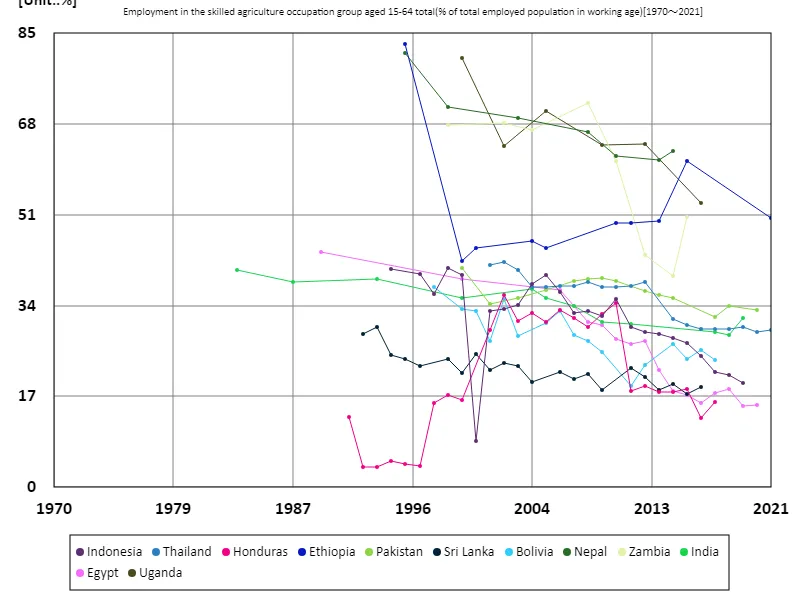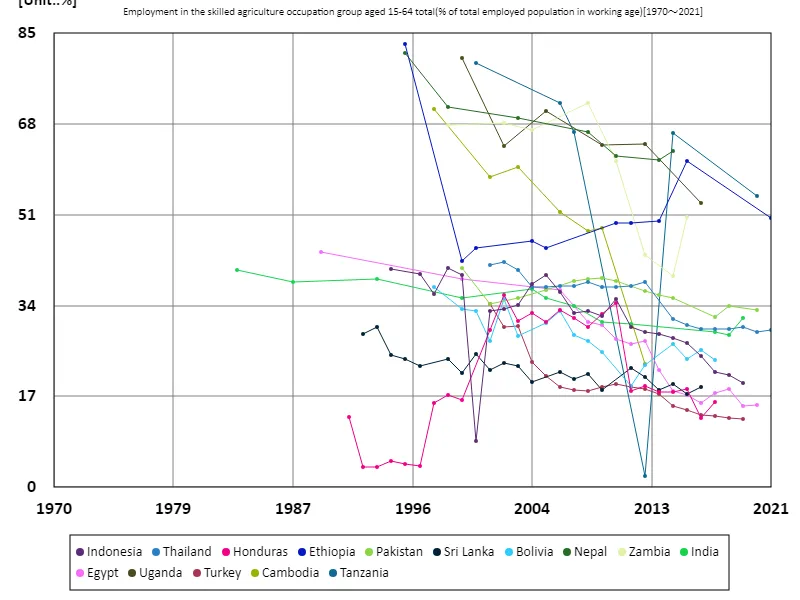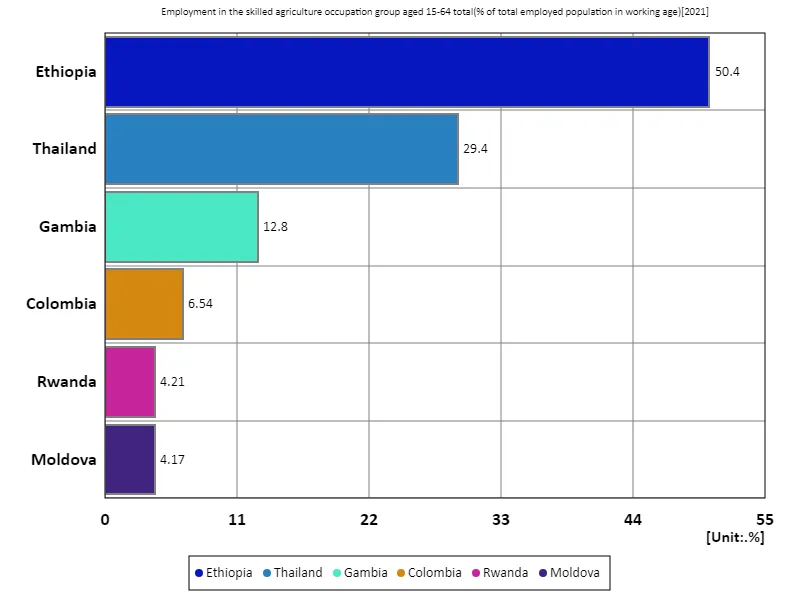- Abstract
- Employment rate in skilled agricultural sector for all 15-64 year olds (percentage of working age employed)
- Employment rate in the skilled agricultural sector for all 15-64 year olds (percentage of working-age employed population) (Worldwide)
- Employment rate in skilled agricultural sector for all 15-64 year olds (percentage of working age employed) (Worldwide, latest year)
- Reference
Abstract
With employment in Ethiopia’s skilled agricultural sector reaching 50.4%, 2021 data shows that agriculture continues to play a vital role in the country’s economy. The high employment rate in the skilled agricultural sector reflects Ethiopia’s reliance on agriculture, which is central to economic activity in the region. Over the past few decades, Ethiopia’s agriculture sector has been largely made up of small family farms and has lagged behind in technological advancements and improved market access, resulting in a high demand for skilled agricultural labour. Against this background, employment rates in Ethiopia’s agricultural sector tend to be higher than in other countries. On the other hand, as agricultural diversification and industrial development progresses, improving the quality of employment and agricultural efficiency will also become challenges in the future.
Employment rate in skilled agricultural sector for all 15-64 year olds (percentage of working age employed)
Looking at data from 1983 to 2021, employment rates in the skilled agricultural sector in Ethiopia show notable changes. In 1995, the employment rate was high at 82.9%, but in recent years it has fallen to 60.8%. This shift suggests that the role of the agricultural sector has changed over time. In the past, Ethiopia’s economy was heavily dependent on agriculture, with most of the workforce concentrated in this sector. However, in recent years, as agricultural efficiency has improved and the industry has diversified, the employment rate in the agricultural sector has been gradually decreasing. This trend is driven by increasing employment opportunities outside of agriculture and increasing urbanization, particularly as young people move to cities. Going forward, there will be a need to improve the quality and efficiency of employment opportunities in the agricultural sector, while a balanced approach to promoting sustainable economic growth will be important.


The maximum is 82.9%[1995] of Ethiopia, and the current value is about 60.8%
Employment rate in the skilled agricultural sector for all 15-64 year olds (percentage of working-age employed population) (Worldwide)
Data from 1983 to 2021 show that employment in Ethiopia’s skilled agricultural sector reached a high of 82.9% in 1995 but has now declined to 60.8%. This change marks a gradual shift from the past when Ethiopia’s agriculture sector was the primary source of employment in the economy. In 1995, agriculture was the backbone of the economy and most of the workforce was dependent on this sector. However, in recent years, economic diversification and urbanization have led to an increase in employment opportunities in sectors other than agriculture. In particular, the migration of young people to urban areas and the spread of education have had an impact, leading to a decline in employment in the agricultural sector. Furthermore, advances in agricultural technology and increased efficiency are also thought to be contributing factors. The decline in employment in the agricultural sector reflects the changing structure of Ethiopia’s economy, and the quality and sustainability of jobs in the agricultural sector will be key challenges in the future.


The maximum is 82.9%[1995] of Ethiopia, and the current value is about 60.8%
Employment rate in skilled agricultural sector for all 15-64 year olds (percentage of working age employed) (Worldwide, latest year)
Based on 2021 data, employment in the skilled agricultural sector recorded a high level of 50.4% in Ethiopia, while the global average was only 17.9%. Ethiopia’s high employment rate reflects the country’s economy remaining heavily dependent on agriculture. This is because the agricultural sector is at the heart of the economy and most of the workforce is concentrated in this sector. However, the global average employment rate is 17.9%, meaning that in many countries, employment in the agricultural sector is relatively low, with the industry and services sectors being the main source of employment. This trend suggests that as the economy develops, industrial diversification and urbanization progresses, employment in the agricultural sector is declining relatively. The ”total 107%” figure reflects the fact that there are several countries where the skilled agricultural workforce exceeds 100% of the working-age population. This means there is a high dependency on agriculture in certain areas and workers in multiple jobs. Overall, there is a clear difference between countries that are heavily dependent on the agriculture sector, such as Ethiopia, and those where non-agricultural sectors are the main source of employment. The challenge going forward is to achieve sustainable growth by improving the efficiency of the agricultural sector and diversifying the economy.


The maximum is 50.4% of Ethiopia, the average is 17.9%, and the total is 107%



Comments